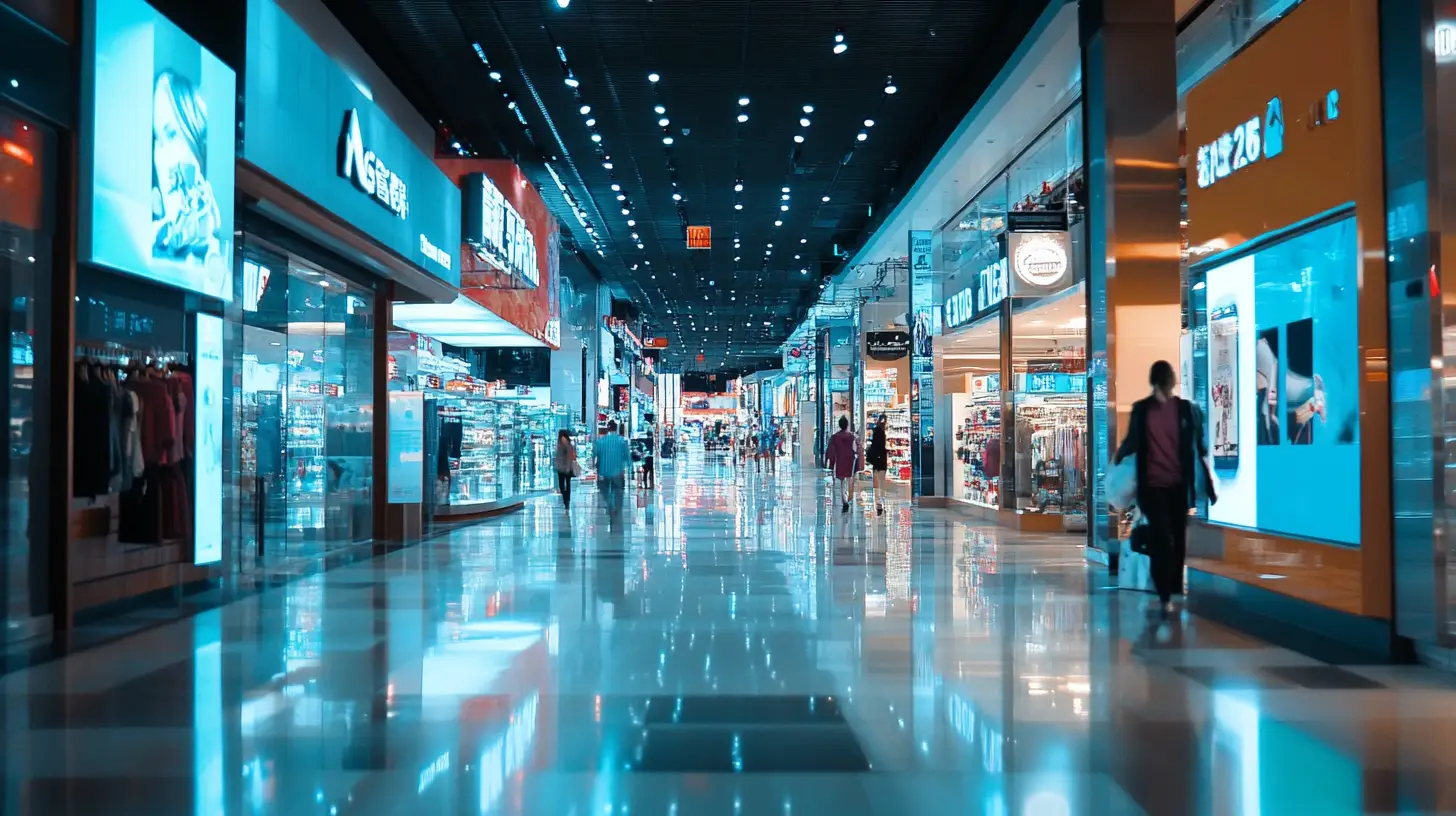Interactive digital advertising in retail stores boosts customer engagement and loyalty by integrating touchless technologies like QR codes and RFID. These tools guarantee safety, minimize physical touch, and offer hands-free navigation, making your store more inviting. Data-driven personalization through IoT provides real-time insights, optimizing customer experiences and store operations. Automated content keeps your messaging relevant and responsive, enhancing product information conveyance. Implementing these strategies elevates customer satisfaction, reduces returns, and drives sales. To fully transform your retail environment and gain valuable consumer insights, explore these innovative approaches further.
Key Takeaways
- Enhance customer engagement through interactive digital signage with touch screens, IoT, and RFID technology.
- Utilize QR codes for touch-free access to product information and promotions, ensuring customer safety and hygiene.
- Leverage real-time data and smart sensors for personalized shopping experiences and effective queue management.
- Implement automated content creation for dynamic updates and engaging digital displays.
- Boost sales and customer loyalty by offering immersive, interactive retail experiences.
Importance of Interactive Signage
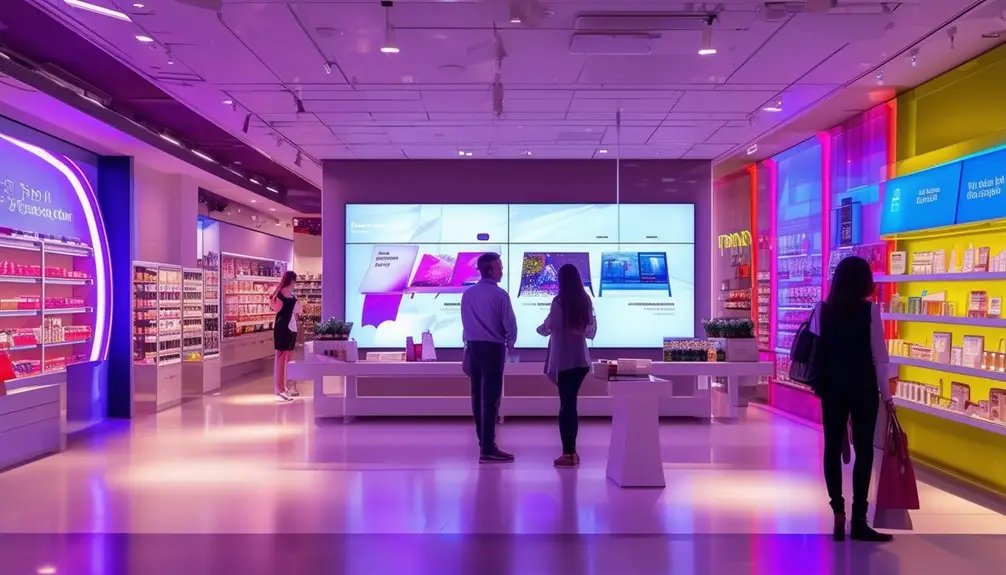
Interactive signage’s ability to integrate advanced technologies like touch screens, IoT, and RFID makes it a necessary tool for enhancing customer engagement and safety in retail stores. When you use interactive displays, you’re not just showcasing products; you’re creating personalized experiences that resonate with your customers. Digital screens equipped with IoT and RFID can track store capacity and customer behavior, allowing you to tailor promotions and information dynamically.
In 2020, these interactive displays proved essential in communicating safety measures, managing store capacity, and delivering emergency alerts. By integrating real-time data, you can guarantee customer safety while keeping them informed and engaged. Imagine the power of a digital screen that not only displays the latest sales but also adapts to changing conditions, providing critical updates on social distancing and store protocols.
Interactive signage helps you offer seamless, customized experiences. With data-driven insights, you can understand customer preferences and adapt your messaging accordingly. This level of personalization fosters deeper customer engagement and loyalty. In today’s retail landscape, where safety and customer experience are paramount, leveraging interactive signage is not just advantageous—it’s indispensable.
Touchless Interactivity Solutions
By integrating touchless interactivity solutions like QR codes and NetMouse, you can greatly enhance safety measures in your retail store. These technologies allow customers to interact with digital displays without physical contact, making the shopping experience both safe and engaging. Embrace these innovations to not only comply with social distancing regulations but also to improve overall customer satisfaction.
Enhancing Safety Measures
Embracing touchless interactivity solutions like QR codes, NetMouse technology, and RFID sensing, retail stores can greatly enhance customer safety and hygiene while delivering a seamless shopping experience. Touchless interactivity minimizes physical touchpoints, ensuring hands-free interactions that align with social distancing guidelines. By integrating QR codes, you allow customers to access product information and promotions simply by scanning with their smartphones. NetMouse technology further reduces the risk of contamination, enabling customers to navigate digital displays without physical contact.
RFID sensing offers another layer of safety and convenience. Customers can lift items embedded with RFID tags to trigger interactive content on nearby screens, a feature known as lift-and-learn capabilities. This not only keeps interactions hands-free but also enriches the shopping experience by providing instant, relevant information about the products.
Here’s a comparison of key touchless interactivity solutions:
| Technology | Benefits |
|---|---|
| QR Codes | Hands-free product info and promotions |
| NetMouse Technology | Touch-free navigation of digital displays |
| RFID Sensing | Contactless item selection |
| Lift-and-Learn | Interactive, informative shopping |
| Hands-Free Interactions | Enhanced safety and hygiene |
QR Code Utilization
Leveraging QR codes on digital displays allows you to offer customers a safe, touch-free way to access product information, promotions, and online orders effortlessly. By integrating QR codes into your digital signage, you enable touchless interactions that prioritize customer safety and hygiene. With a quick scan from their mobile devices, customers can navigate to websites, participate in polls, claim coupons, and place online orders without any physical contact.
QR codes provide a seamless, interactive experience that enhances customer engagement. For instance, using technology, customers can interact with digital displays through their smartphones, eliminating the need for touch entirely. This not only fosters a hygienic shopping environment but also caters to the growing demand for touchless solutions in retail.
QR codes offer a strategic advantage by collecting data on customer interactions. Analyzing this data helps you refine your marketing strategies, ensuring you meet customer needs more effectively. The convenience and hygiene benefits of QR codes make them an essential component of modern retail advertising, driving both customer satisfaction and safety. By adopting this touchless technology, you can transform the shopping experience and stay ahead in a competitive market.
Data-Driven Personalization
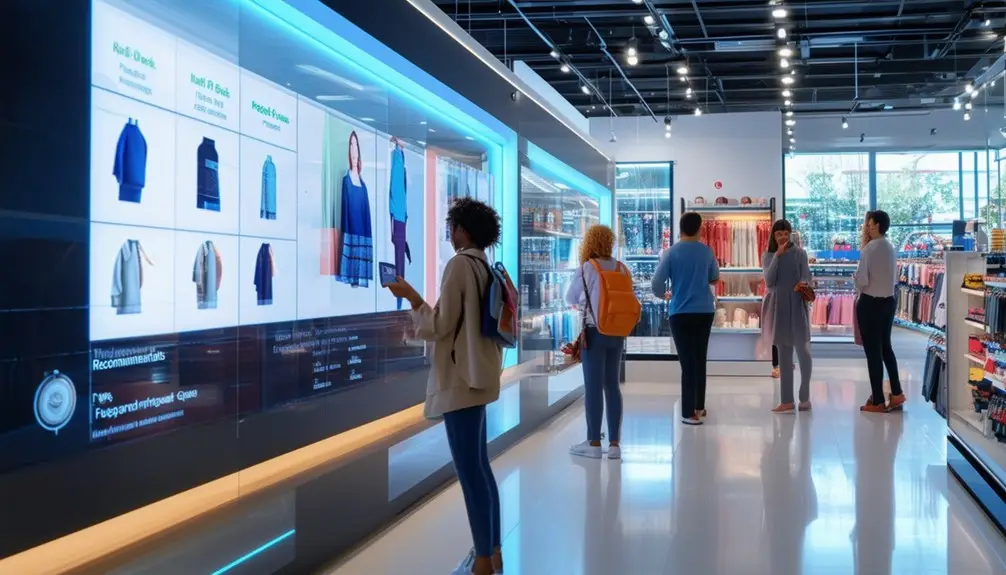
You can harness real-time information broadcasting and smart queue management to offer highly personalized shopping experiences. By leveraging data, you’ll not only improve store efficiency but also tailor customer interactions to their unique preferences. This approach makes your marketing efforts more impactful and engaging.
Real-Time Information Broadcasting
Integrating IoT with digital signage transforms how retail stores broadcast current information and achieve data-driven personalization. By leveraging IoT integration, you can enhance interactive digital advertising to deliver immediate updates and smart solutions, making customer experiences more engaging and customized.
Current information broadcasting becomes more efficient with IoT-enabled digital signage. For example, queue management systems can dynamically adjust based on store capacity, guaranteeing a smooth flow of customers and compliance with social distancing guidelines. Additionally, the lift-and-learn feature revolutionizes customer interaction by using RFID sensing technology to allow touchless item selection, providing a seamless shopping experience.
Here’s how IoT integration in digital signage can make a difference:
- Immediate updates: Instantly broadcast promotions, inventory changes, or safety announcements.
- Interactive displays: Engage customers with personalized content based on real-time data.
- Capacity management: Guarantee compliance with local regulations by live-tracking store capacity.
- Touchless interaction: Use the lift-and-learn feature to enable contactless product exploration.
Smart Queue Management
Smart queue management in retail stores harnesses IoT-enabled digital signage to track and manage customer flow in real-time, ensuring a seamless and personalized shopping experience. By implementing RFID sensing technology, you can monitor store capacity and maintain social distancing effortlessly. This data-driven approach not only helps you comply with local regulations but also enhances safety by reducing physical contact.
Interactive digital solutions like the Lift-and-Learn feature allow customers to interact with products without touching screens, promoting a safer environment. This feature also provides valuable data on customer preferences, which can be used to optimize store operations and improve the overall shopping experience.
To give you a clearer picture, here’s a table summarizing the benefits of smart queue management:
| Feature | Benefit | Impact |
|---|---|---|
| Digital Signage | Real-time customer flow tracking | Enhanced safety and compliance |
| RFID Sensing Technology | Contactless navigation | Improved customer experience |
| Lift-and-Learn Feature | Screenless interaction | Better data on preferences |
Personalized Shopping Experiences
Leveraging IoT integration, personalized shopping experiences transform retail by delivering real-time, tailored recommendations that boost customer engagement and loyalty. By using data-driven personalization, you can offer each customer a unique journey through interactive displays and real-time information. This approach not only enhances the shopping experience but also secures customer safety and satisfaction.
Incorporating these technologies, you’ll find that interactive digital advertising becomes more effective and engaging. Here are some key features that can revolutionize your retail environment:
- RFID Sensing Technology: Enable customers to navigate and select items without physical contact, improving both convenience and security.
- Lift-and-Learn Displays: Allow customers to interact without touching screens, providing personalized information and recommendations.
- Smart Queue Management: Track store capacity and secure social distancing, further enhancing customer safety.
- Real-Time Analytics: Use IoT to gather data and offer personalized experiences that make each visit memorable and engaging.
Automated Content Creation
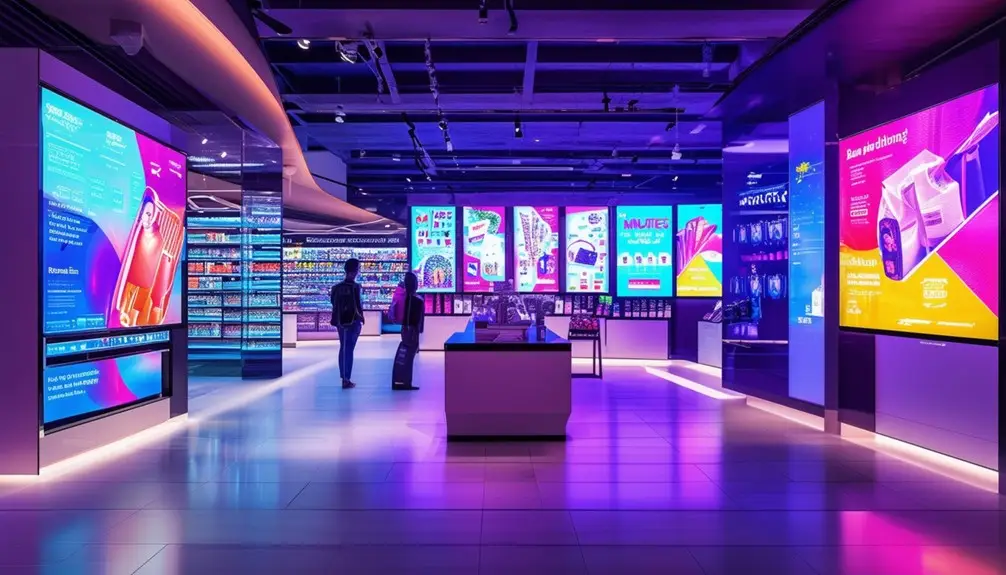
Harnessing automated content creation, digital signage in retail stores can instantly exhibit vital updates like emergency protocols, schedule changes, and new product launches. By integrating interactive signage, you can guarantee that your digital displays are not only captivating but also responsive to real-time situations. For example, during an emergency, interactive signage can guide customers safely out of the store, enhancing overall safety protocols.
Automated content creation allows these digital displays to adapt swiftly to changing circumstances, ensuring that your customers are always informed. Picture a scenario where store capacity sensors detect overcrowding. Your signage could then automatically exhibit social distancing reminders, helping maintain a safe shopping environment. This kind of dynamic content creation secures that your store remains compliant with safety measures without manual intervention.
When you introduce new products, automated systems can instantly update all digital displays, ensuring timely and consistent communication across all touchpoints. This not only enhances customer experience but also drives sales by keeping customers informed about the latest offerings. Essentially, automated content creation transforms your retail space into a highly adaptive, customer-centric environment, leveraging interactive signage to keep everyone safe and informed.
Benefits of Interactive Retail
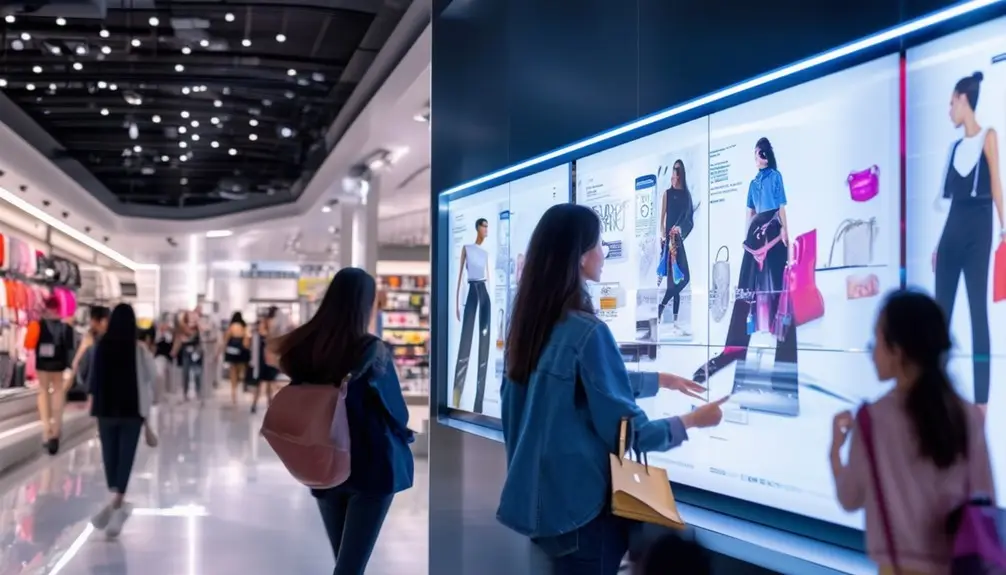
Interactive retail transforms the shopping experience by boosting customer engagement, driving brand loyalty, and ultimately increasing sales. By integrating digital elements into your retail strategy, you can offer a more immersive and personalized experience for customers. This approach not only conveys essential product information but also enhances the overall customer experience.
Consider these benefits of interactive retail:
- Enhanced Engagement: Interactive elements like smart mirrors and augmented reality keep customers engaged and entertained, making their shopping experience more enjoyable.
- Reduced Returns: Providing quick answers to customer questions through digital interfaces helps them make informed decisions, reducing the likelihood of returned merchandise.
- Personalized Experiences: Tailored recommendations based on customer behavior and preferences can greatly improve satisfaction and loyalty.
- Streamlined Buyer’s Journey: Interactive tools facilitate a smoother, more efficient shopping process, making it easier for customers to find and purchase what they need.
Incorporating these digital strategies into your retail environment not only meets the modern customer’s expectations but also sets your brand apart from competitors. By focusing on interactive retail, you’re not just selling products; you’re creating memorable and engaging experiences that keep customers coming back. This data-driven approach guarantees your retail space remains dynamic and responsive to customer needs.
Implementing Interactive Strategies
To effectively implement interactive strategies in your retail store, start by integrating touchless technologies like QR codes to create seamless, hands-free customer interactions. QR codes can guide customers to product details, reviews, and even personalized recommendations, enhancing the overall customer experience. These touchless solutions not only streamline the shopping process but also cater to the growing demand for safer, contactless interactions.
Next, leverage IoT technologies to transform your store into an interactive retail environment. Use smart sensors and devices for real-time data tracking and queue management, ensuring efficient in-store operations and reducing customer wait times. IoT can also provide valuable insights into consumer behavior, enabling you to tailor personalized recommendations and marketing strategies more effectively.
Focusing on interactive retail strategies boosts customer engagement and brand loyalty. Create immersive experiences through digital displays and augmented reality, making your store a destination rather than just a place to shop. By offering interactive and engaging experiences, you’re more likely to drive sales and reduce rates of returned merchandise as customers make more informed purchasing decisions.
Incorporate these interactive strategies to elevate your retail store, providing a dynamic and personalized shopping journey that meets modern consumer expectations.
Conclusion
You’ll be amazed to know that interactive digital ads can boost customer engagement by up to 47%! By integrating touchless interactivity, data-driven personalization, and automated content creation into your retail strategy, you’re not just keeping up with the times—you’re staying ahead. Interactive signage isn’t just a trend; it’s a game-changer that can elevate your customer’s shopping experience and drive sales. Don’t wait—start implementing these innovative solutions today and see the difference for yourself!
Frequently Asked Questions
What Is Interactive Retailing?
Interactive retailing engages you through touch, sight, sound, and movement in stores. You’ll experience virtual try-ons, digital courts, and smart mirrors. It boosts engagement, loyalty, and sales while reducing returns through personalized, data-driven experiences.
Why Are Retailers Integrating Digital Technologies Into Physical Stores?
You integrate digital technologies into physical stores to enhance customer engagement, gather valuable data, and create seamless omnichannel experiences. These tools help you dynamically adjust pricing, build trust, and prevent customers from researching products elsewhere.
What Is Digital Retail Marketing?
Digital retail marketing uses digital tech to enhance in-store experiences. It creates immersive brand interactions, provides instant product info, collects customer data, and integrates online and offline shopping, boosting sales and building loyalty strategically.
How Are Digital Devices Used in Retail?
Imagine walking into a store, screens beckoning you with personalized offers. You touch a display, uncovering hidden deals and real-time pricing. These digital devices don’t just sell; they gather data to optimize your shopping journey.

